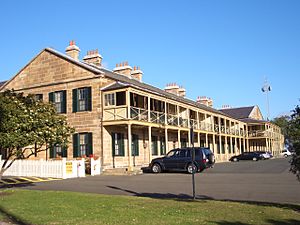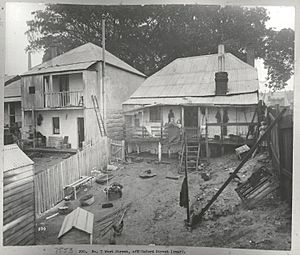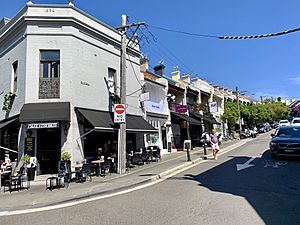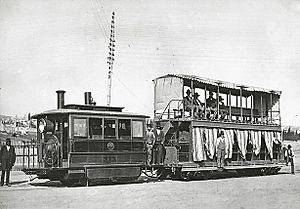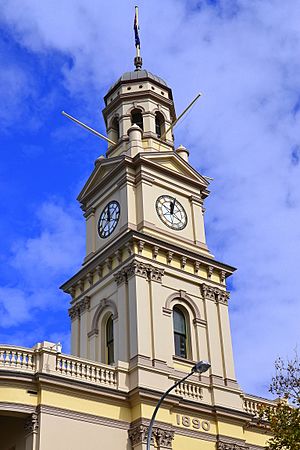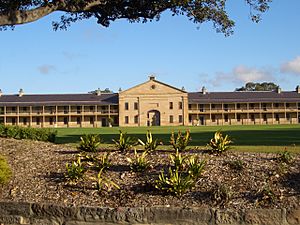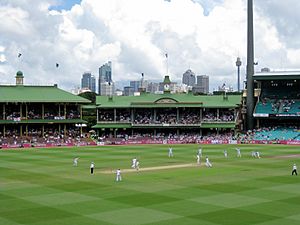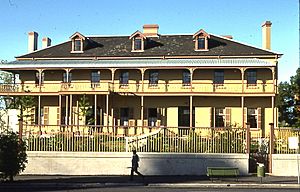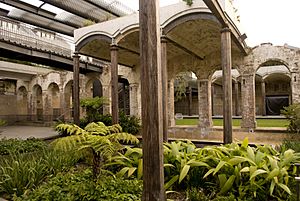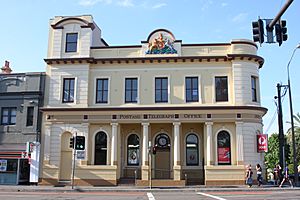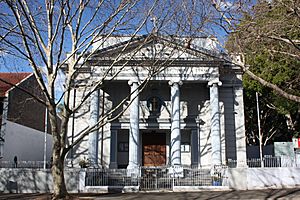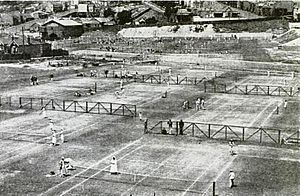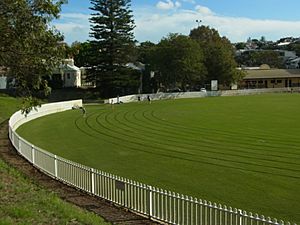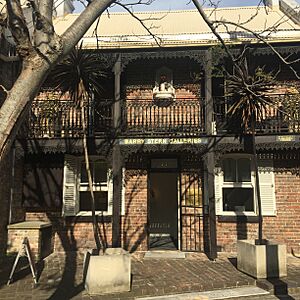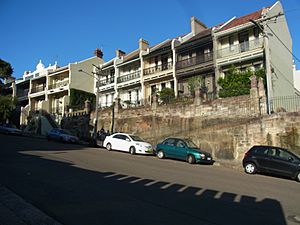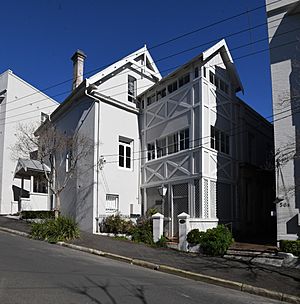Paddington, New South Wales facts for kids
Quick facts for kids PaddingtonSydney, New South Wales |
|||||||||||||||
|---|---|---|---|---|---|---|---|---|---|---|---|---|---|---|---|

|
|||||||||||||||
| Postcode(s) | 2021 | ||||||||||||||
| Elevation | 68 m (223 ft) | ||||||||||||||
| Area | 1.5 km2 (0.6 sq mi) | ||||||||||||||
| Location | 3 km (2 mi) east of Sydney CBD | ||||||||||||||
| LGA(s) |
|
||||||||||||||
| State electorate(s) | Sydney | ||||||||||||||
| Federal Division(s) | Wentworth | ||||||||||||||
|
|||||||||||||||
Paddington is a lively suburb in the eastern part of Sydney, New South Wales, Australia. It's located about 3 kilometres east of the main city centre. Paddington is special because it sits across two local government areas: part of it is in the City of Sydney, and the other part is in the Municipality of Woollahra. People often call it "Paddo" for short.
Paddington shares its borders with several other suburbs. To the west, you'll find Darlinghurst. To the east are Centennial Park and Woollahra. To the north, it borders Edgecliff and Rushcutters Bay. And to the south, you'll find Moore Park.
Contents
History of Paddington
First People of Paddington
The land where Paddington now stands has a rich history connected to the Cadigal people. They were part of the Dharug (or Eora) language group, which also included the area of today's Sydney central business district. It's known that Oxford Street, a main road today, was once a walking track used by Aboriginal people because it was the easiest route.
Sadly, many Aboriginal people in Sydney, estimated around 1000, died from a smallpox outbreak in 1789, just one year after the First Fleet arrived. Some experts believe the Cadigal people moved to other areas where the Eora language was spoken. When Robert Cooper started building his first house in Paddington, about 200 Koori people were living nearby in Woolloomooloo, in homes built for them by Governor Macquarie.
After Europeans settled, Paddington didn't have a large Indigenous population. In the 1930s, while places like Redfern became important centres for Aboriginal people looking for work, Paddington mostly remained a home for European working-class families.
European Settlement and Growth
- 1788–1840
- Early Days
In 1788, the First Fleet arrived in Sydney Harbour and started a settlement in Sydney Cove. The land that would become Paddington was about 3 kilometres east. This area had a high sandstone ridge and streams leading to a marshy cove. At first, the new settlers didn't pay much attention to it, except to collect rushes for thatch.
A road was built by Governor Hunter as early as 1803, following a path used by local Aboriginal people. This road went to South Head. Governor Macquarie improved it in 1811 for military reasons, so wagons could use it. Later, in 1820, Major Druitt made it even better for quicker access to the signal station at South Head. It also helped people reach the fancy houses being built by wealthy colonists. This road was later called the Old South Head Road.
The first large piece of land in Paddington, about 40 hectares, was given to Robert Cooper, James Underwood, and Francis Ewen Forbes in 1823. They used it to start the Sydney distillery. A mill, run by the Gordon family, also started grinding wheat in the early 1830s.
Robert Cooper built his large house, Juniper Hall, on the ridge of South Head Road. James Underwood built his house on Glenmore Road. The name "Paddington" came about in October 1839 when James Underwood divided 50 acres of his land. He named this new area the Paddington Estate, after a place in London. It stretched from Oxford Street down to what is now Paddington Street.
- 1841–1900
- A Growing Village
After the Victoria Barracks started being built in 1841, the village of Paddington quickly grew. Many of the first homes were for the workers building the Barracks, like stonemasons, carpenters, and labourers. This led to a clear difference in the area: working-class people lived mostly near South Head Road, while wealthier families lived in larger houses facing the harbour in 'Rushcutters Valley'.
Paddington grew very fast, with large pieces of land being divided for many terrace-style houses. By 1862, there were 535 houses and 2,800 people. By 1883, the number of houses jumped to 2,347. The population became very dense, meaning many people lived close together.
- 1901–2000
- Changes and Preservation
In the early 1900s, Paddington was at its busiest, with 26,000 people living in 4,800 houses. Health improved as a sewer system was built.
After World War I, Paddington faced social problems. Many people died in the influenza epidemic of 1919. Developers started to see crowded areas like Paddington as unhealthy. They promoted new "garden suburbs" instead. During the Depression, many people in Paddington, especially those who rented or had unskilled jobs, faced high unemployment.
After World War II, a plan for Sydney suggested that Paddington was an old area that should be completely rebuilt. A 1947 map even showed almost all existing houses being torn down and replaced with apartment blocks. However, many new migrants from Europe found Paddington affordable and a good place to live. Because of this, the idea of tearing down the old houses faded away. In the 1960s, more middle-class people, sometimes called 'Bohemians', moved in, making Paddington a very 'multi-cultural' place.
From 1960 onwards, many professionals, especially those who had lived overseas, saw how great Paddington was because it was so close to the city. They started fixing up the old houses, which were often in bad condition. This led to a new appreciation for the area's history and beauty. In 1968, a big change happened: four hundred acres of terrace houses were protected as Australia's first conservation area. A local group called the Paddington Society, started in 1964, helped make this happen.
Because of its well-preserved Victorian buildings, Paddington is often compared to London. In 1996, a travel journalist from The New York Times noted that while Sydney often looks like California, Paddington, or Paddo, feels more like parts of London due to its many terrace houses.
Shopping and Local Hubs
Paddington has many different shopping and activity areas.
Oxford Street
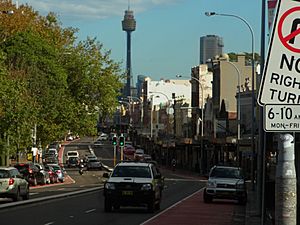
Oxford Street is a long shopping street in Paddington. It's famous for its many clothing boutiques, which attract tourists. You can also find bookstores and a cinema at one end, and more personal services like hair and nail salons closer to Woollahra. Parking can be tricky here, and rents are high for shops. Newer buildings have been built to fit in with the older 19th-century style of Oxford Street.
Paddington Markets
The Paddington Markets are held every Saturday in the grounds of the Paddington Uniting Church on Oxford Street. They started in 1973. The market is a great place for local craftspeople, fashion designers, artists, and jewellery makers to show and sell their creations.
William Street
William Street, just off Oxford Street, is home to a unique mix of designers and traders. They sell their goods from tiny shops and terrace houses. The William Street Festival is a popular event held here every September since 2009.
Five Ways
Five Ways is a special intersection in the northern part of Paddington, known for its village feel. It has shops for daily needs and many places to eat with outdoor seating.
Back Streets
In the quieter back streets, you'll find many hotels, art galleries, interior design shops, antique dealers, and restaurants. Even with big shopping malls nearby, you can still find small corner shops on many streets like Albion, Boundary, Cascade, and others.
Getting Around Paddington
Trams
Paddington used to have two tram lines. One ran along Oxford Street, and the other went through Five Ways. The Oxford Street line opened in 1884 as a steam tramway. Electric trams started running on the same line in 1902. Both tram lines closed in 1960.
Buses
Today, Paddington is served by buses that run along Oxford Street or through Five Ways. Some popular bus routes include:
- 333: From Circular Quay to North Bondi
- 352: From Bondi Junction station to Marrickville Metro
- 440: From Bondi Junction station to Rozelle
- 389: From Bondi Junction station to Pyrmont
Buses also run on New South Head Road, connecting the city to areas like Woolloomooloo, Kings Cross, and Watsons Bay.
Trains
The closest train station to Paddington is Edgecliff. It's an underground station on the Eastern Suburbs line of the Sydney Trains network.
Famous Landmarks
Paddington Town Hall
Sir Henry Parkes laid the first stone for the Paddington Town Hall in 1890, when Paddington was its own separate town. It opened in 1891 and is a great example of Victorian architecture in Sydney. The clock tower is 32 metres tall and stands out on the Oxford Street ridge.
A fun fact about the clock: the northern side, facing Oxford Street, has unusual Roman numerals! Instead of the usual numbers, it spells out E.D.V.A.R.D.U.S T.H.E VII (Edward the Seventh). This was done to celebrate the coronation of King Edward VII.
Today, the building has radio studios, a cinema, the Paddington Library, and is used for private events. In 1908, a meeting was held here where the Eastern Suburbs Rugby League club, now known as the Sydney Roosters, was officially formed.
Victoria Barracks
Victoria Barracks was built between 1841 and 1849. It's one of Australia's most famous military buildings. The sandstone buildings were designed by Lieutenant-Colonel George Barney, who also built Fort Denison. You can visit Victoria Barracks, including its museum, on Thursdays.
Sydney Cricket Ground
The Sydney Cricket Ground (SCG) is located on Moore Park Road, on Paddington's southern edge. The first test cricket match was played here in February 1882. The SCG is also the home ground for the Sydney Swans Australian Rules Football team. You can take public tours of the SCG every day except Sundays.
Sydney Football Stadium
The Sydney Football Stadium (SFS or Allianz Stadium) is also on Moore Park Road, next to the SCG. It's the home ground for the Sydney Roosters (rugby league), NSW Waratahs (rugby union), and Sydney FC (soccer). The original stadium was taken down in 2019, and a new one was built, opening in September 2022.
Juniper Hall
Juniper Hall was built by Robert Cooper, who was once a convict, in the 1820s. It's the oldest house in Paddington. It's a large, impressive building located across from the Paddington Town Hall. The National Trust of Australia helped restore it. In 2013, it was sold to the Moran family for the Moran Arts Foundation, which uses it for art exhibitions and events.
Oxford Street
Oxford Street was originally an Aboriginal walking track. Later, it became a faster route to South Head. Trams used to run along Oxford Street to Bondi Beach. While it once served the local residents, today the street is a popular place for many visitors to walk around and window shop.
Paddington Reservoir
The Paddington Reservoir on Oxford Street supplied water to parts of Sydney between 1866 and 1899. In 2006, the old parts of the reservoir were turned into a beautiful sunken garden called the Paddington Reservoir Gardens, or Walter Read Reserve.
Trumper Park Oval
Trumper Park Oval, located at the corner of Glenmore Road and Hampden Street, is named after Victor Trumper, a famous Australian test cricketer. The oval has a long history with the Australian Football East Sydney club, and is also used for cricket and local athletics. There are walking trails through a bushy valley that connect to nearby streets and lead to the Paddington Bowling Club and Trumper Park Tennis Centre.
White City Tennis Centre
The White City Tennis Centre has been a big part of Australian Tennis since it opened in 1922. Many important events have been held here, including the New South Wales Open, the Australian Open, and the Davis Cup. In 1954, a record crowd of 25,000 people watched the Davis Cup final here, which is still the largest crowd for an outdoor Davis Cup match in Australia.
Historic Places
Paddington has many places listed for their historical importance. Some of these include:
- 1 Ormond Street: Juniper Hall, Paddington
- 56a Ormond Street: Engehurst
- 246 Oxford Street: Paddington Post Office
- 1 Young Street: Paddington Substation
- 249 Oxford Street: Paddington Town Hall
- 255a Oxford Street: Paddington Reservoir
- 302–304 South Dowling Street: Saint Sophia's Cathedral, Sydney
Other important heritage sites include:
- Victoria Barracks, built 1841–1848, on Oxford Street
- Paddington Court House, on Jersey Road
- Paddington Public School, with buildings from 1870 and 1892, on Oxford Street
- Uniting Church and Parsonage, 1877, on Oxford Street
- St Matthias Church Group, 1859–1861, on Oxford Street
- Royal Hotel, 1885, on Glenmore Road
- Tabor Cottage, on Jersey Road (formerly Paddington Watch House)
Places of Worship
Paddington has several places of worship:
- Paddington Church of Christ, Paddington Street
- Paddington Uniting Church, Oxford Street
- St Francis of Assisi Catholic Church, Oxford Street
- St Georges Anglican Church, Five Ways
- St Matthias Anglican Church, Oxford Street
- St Sophia's Greek Orthodox Cathedral, corner of South Dowling Street and Napier Street
Schools and Learning
Paddington offers various educational facilities:
- Preschools
- KU Peter Pan Paddington Preschool, Union Street
- KU Kira Child Care Centre, corner of Moore Park Road and Oatley Road
- Paddington Church of Christ Kindergarten, Paddington Street
- Paddington Children's Centre, Paddington Uniting Church, Oxford Street
- SDN Paddington, Heeley Street
- Primary Schools
- Glenmore Road Public School, Glenmore Road and Cambridge Street
- Paddington Public School, Oxford Street
- St Francis of Assisi School, Oxford Street
- Sydney Grammar School (Edgecliff Preparatory School), Alma Street
- Tertiary Education (Colleges/Universities)
- UNSW Art & Design, Napier Street
- Academy of Makeup, Victoria Street
Community and Fun
- Community Groups
- Paddington-Darlinghurst Community Working Group
- The Paddington Society, a local action group
- Paddington Woollahra RSL Club, 220–232 Oxford Street
- Sports
- Maccabi Tennis White City, Alma Street
- Paddington Lawn Bowls Club, Quarry Road
- The Palms Tennis Centre, Quarry Road
- UTS Australian Football Club plays home games at Trumper Park Oval
- Libraries
- Paddington Library, a branch of Woollahra Library, is located at 249 Oxford Street, on the ground floor of Paddington Town Hall.
- Cinemas
- Chauvel Cinema, Oatley Road next to Paddington Town Hall (named after filmmaker Charles Chauvel)
- Palace Verona Cinema, 17 Oxford Street
Art Galleries
Paddington is known for its many private art galleries, including:
- Art House Gallery, 66 Mclachlan Avenue
- Australian Galleries, 15 Roylston Street
- Blender Gallery, 16 Elizabeth Street
- Christopher Day Galleries, corner of Elizabeth & Windsor Streets
- Martin Browne Contemporary, 15 Hampton Street
- Maunsell Wickes at Barry Stern Galleries, Glenmore Road
- Moran Arts Foundation, Juniper Hall 250 Oxford Street
- Roslyn Oxley 9 Gallery, 8 Soudan Lane
- Sabbia Gallery, 120 Glenmore Road
- Savill Galleries, 156 Hargrave Street
- Sherman Contemporary Art Foundation, 16 Goodhope Street
- Wagner Art Gallery, 39 Gurner Street
Other galleries:
- Galleries UNSW, COFA, corner of Oxford Street and Greens Road
- Kudos Gallery, 6 Napier Street
Hotels
Paddington has a large number of hotels, though only a few offer accommodation:
- Arts Hotel, 21 Oxford Street
- Bellevue Hotel, 159 Hargrave Street
- Captain Cook Hotel, 162 Flinders Street
- Four in Hand Hotel, 105 Sutherland Street
- Grand National, 161 Underwood Street
- Imperial Hotel, 252 Oxford Street
- London Hotel, 85 Underwood Street
- Lord Dudley, 236 Jersey Road
- Olympic Hotel, 308 Moore Park Road
- Paddington Arms Hotel 384 Oxford Street
- Paddington Inn Hotel, 338 Oxford Street
- Rose, Shamrock and Thistle, 27–30 Oxford Street
- Royal Hotel, 237 Glenmore Road, Five Ways
- The Light Brigade Hotel, 2A Oxford Street (Woollahra)
- The Village Inn, 9–11 Glenmore Road
- Unicorn Hotel, 106 Oxford Street
Healthcare and Aged Care
Royal Hospital for Women (RHW)
The Royal Hospital for Women officially opened on Glenmore Road in 1905. It stayed at this location for almost 100 years, providing healthcare for many women and their babies. In 1997, the hospital moved to Randwick. The Paddington site was then sold and developed into housing, now known as Paddington Green.
Scottish Hospital
The Scottish Hospital on Cooper Street includes gardens and the original house called 'The Terraces'. This was one of the ten large land grants given by Governor Bourke in the 1830s. In 2010, plans were made to update and expand the aged care services offered at the Scottish Hospital site.
Housing in Paddington
Before 1945
Paddington's current look, with its many 'Victorian' houses, mostly developed during a 30-year period starting in the mid-1870s. This growth was helped by better public transport, first with horse-drawn buses and then with steam trams that went to Bondi in 1884.
Although the suburb's growth slowed during the economic tough times of the 1890s, it was mostly finished by the early 1900s. In the first half of the 20th century, people started to dislike terraced housing, seeing inner-city areas like Paddington as 'slums'. Paddington, which was mainly a working-class area, was affected by this change in opinion.
After 1945
After World War II, Paddington continued to be home to many working-class families who had lived there for generations. It also became home to migrant workers and their families from Europe, who were used to living close to their neighbours. From the early 1960s, artists and students also moved in, attracted by the cheap rents.
Around the same time, the area started to become more popular with wealthier residents, a process called gentrification. This sped up in the following years. With this change came a new interest in the area's unique history and beauty, and people realized that Paddington needed to be protected.
Population Facts
At the 2021 census, there were 12,701 people living in Paddington.
Paddington is known for its high-wealth status, which comes from its great location and lively local culture. The average weekly income for households in Paddington is $2,792, which is much higher than the national average.
Even with its wealth, the area is culturally diverse. Residents come from various backgrounds, including England (8.0%), New Zealand (3.5%), the US (2.1%), South Africa (1.2%), and France (0.9%).
Most people (78.1%) speak only English at home. Other languages spoken include French, Spanish, Italian, and Greek.
Most homes in Paddington are semi-detached, row, or terrace houses, making up 65.1% of residences. Apartments make up 32.3%.
The housing market is strong, with the average house price being $2,215,000, showing how desirable the suburb is. Many residents are highly educated, with 41.8% holding a Bachelor's degree or higher. This shows that Paddington is a hub for educated professionals.
Famous People from Paddington
Many notable people have lived in Paddington, including:
- Phillip Adams, a broadcaster
- David Boyd, an artist
- Ita Buttrose, a journalist and TV personality
- Noel Ferrier, an actor
- Peggy Glanville-Hicks, a composer
- Alan Kippax, a cricketer
- Margaret Olley, an artist
- Victor Trumper, a cricketer
- David Warner, a cricketer
- Jacki Weaver, an actress
|



